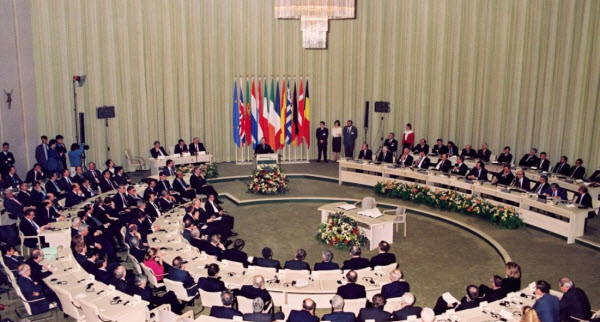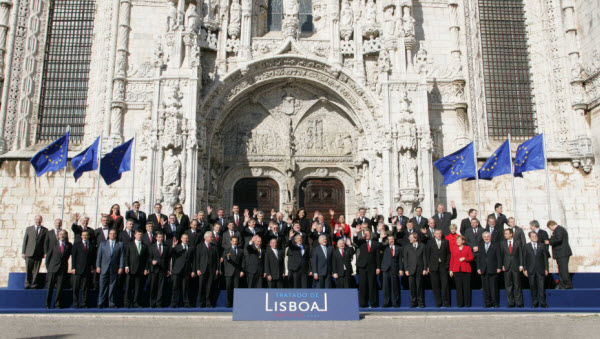The European Union (EU) is an international European organization responsible for regulating the economic, social, and security policies of its member states. It was established by the Maastricht Treaty, which came into force on November 1, 1993. The EU aims to achieve European political and economic integration by creating a single currency, the euro, and by fostering consensus on foreign and security policies. It also aims to enhance common citizenship, cooperation in migration and asylum, and judicial matters. Due to its significant efforts in promoting peace and democracy across Europe, the EU was awarded the Nobel Peace Prize in 2012.
Initially, the EU was limited to Western European countries. However, after the collapse of the Soviet Union, it began to expand into Central and Eastern Europe. As of now, following the United Kingdom’s departure in 2020, the EU consists of 27 member states: Austria, Belgium, Bulgaria, Croatia, Cyprus, the Czech Republic, Denmark, Estonia, Finland, France, Germany, Greece, Hungary, Ireland, Italy, Latvia, Lithuania, Luxembourg, Malta, the Netherlands, Poland, Portugal, Romania, Slovakia, Slovenia, Spain, and Sweden.
History of the European Union
The Concept of the European Union
The European Union represents a series of efforts to integrate European countries since World War II. After the war, many Western European nations sought to strengthen economic, social, and political ties to achieve economic growth, military security, and enduring reconciliation between France and Germany. To this end, in 1951, leaders from six countries—Belgium, France, Italy, Luxembourg, the Netherlands, and West Germany—signed the Paris Treaty, which established the European Coal and Steel Community (ECSC). The United Kingdom was invited to join, and in 1955, sent a representative to monitor discussions on its development. However, the Labour government under Prime Minister Clement Attlee rejected membership, partly due to a desire to maintain economic independence. Nevertheless, the ECSC created a free trade area for essential economic and military resources—coal, coke, steel, scrap, and iron ore—and established several governing institutions: (1) the High Authority for administration, (2) the Council of Ministers for legislation, (3) a Common Assembly for policy-making, and (4) a Court of Justice to interpret the treaty and resolve related disputes. Subsequent international treaties, with modifications, built upon this model, eventually forming the principles of the EU.
Creation of the European Economic Community (EEC)
On March 25, 1957, the six ECSC members signed the Rome Treaties, establishing the European Atomic Energy Community (Euratom) to facilitate nuclear energy development and research, and the European Economic Community (EEC), which created a common market by removing most barriers to the movement of goods, services, capital, and labor. It also prohibited most policies or agreements that hindered market competition and called for a common agricultural policy and external trade policy.
The EEC Treaty required member states to abolish or revise several national laws and regulations, implement fundamental reforms in tariffs and trade policies by July 1968, and eliminate national regulations favoring domestic over foreign industries. It also called for common rules against anti-competitive behavior and monopolies and established the European Social Fund to promote employment by facilitating geographical and professional mobility for workers, recognizing social policy as a key element of economic integration.
Despite the establishment of common agricultural policies, extending these reforms to agriculture proved challenging. It became necessary for states to intervene to protect farmers’ living standards, enhance agricultural self-sufficiency, and ensure reliable and affordable product supplies. As with the ECSC, four main governing institutions were established for the EEC: (1) a Governing Commission, (2) a Council of Ministers, (3) a Council, and (4) a Court. By 1965, the EEC members signed the Brussels Treaty, merging the EEC Commission, Euratom, and the High Authority of the ECSC into a single Commission, and combining the councils of the three organizations into a single Council of Ministers. EEC, Euratom, and ECSC were collectively referred to as the European Communities and later became the main institutions of the EU.
During the 1970s and 1980s, the EEC gradually expanded its membership and scope. In 1973, the United Kingdom, Denmark, and Ireland joined, followed by Greece in 1981 and Portugal and Spain in 1986. The EEC’s common external trade policy led to pressures for common foreign and development policies. In the early 1970s, the European Political Cooperation (EPC) was established, later renamed the Common Foreign and Security Policy, managed through regular meetings of foreign ministers from each country to coordinate foreign policy. In 1975, the European Regional Development Fund was created to address regional economic disparities and provide additional resources to Europe’s most deprived areas. Members also made several attempts to collectively manage their exchange rates, leading to the creation of the European Monetary System in 1979.
The Single European Act
The Single European Act (SEA), which came into force on July 1, 1987, significantly expanded the EEC’s scope. It provided a legal basis for the EPC, leading to increased coordination of foreign policy among members. Despite decisions on foreign policy being made outside EU institutions, the SEA formally incorporated the European Regional Development Fund into the European Community treaties as a new element aimed at economic and social cohesion, encouraging the development of economically disadvantaged regions. The SEA also led to a substantial increase in funding for social and regional programs.
Overall, the SEA set a timeline for completing the single market, despite various legal, technical, financial, and physical barriers that restricted the movement of goods, labor, capital, and services. For instance, differences in national health and safety standards for consumer goods posed potential trade barriers. To facilitate the completion of the single market, the legislative committee was to propose amendments, consult Parliament, and then the Council of Ministers would make a final decision. Achieving consensus was challenging as each member had veto power over all legislation. The SEA streamlined this process by adopting majority voting, requiring approximately two-thirds of all member votes for legislative approval, thereby increasing the role of the European Parliament.
The Maastricht Treaty or the Treaty on European Union
The Maastricht Treaty (officially known as the Treaty on European Union), signed on February 7, 1992, officially established the EU. The treaty faced significant resistance in some countries, such as Denmark, where voters concerned about sovereignty rejected the original treaty in a June 1992 referendum. However, the revised treaty was approved in a May 1993 referendum. French voters narrowly approved the treaty in September, and in July 1993, British Prime Minister John Major called a confidence vote to secure its passage. The revised treaty came into force on November 1, 1993.

The treaty comprised three main pillars: (1) the European Communities, (2) Common Foreign and Security Policy, and (3) Justice and Home Affairs. It renamed the EEC to the European Community (EC), which became the core of the new EU and expanded the European Commission’s powers, including oversight of community policies on development, education, public health, consumer protection, environmental protection, and social and economic cohesion. The treaty also introduced EU citizenship, granting citizens the right to vote and stand for election in local and European Parliament elections in their country of residence, regardless of their national citizenship.
Additionally, the Maastricht Treaty set a framework for integrating monetary policy within the EC and formalized plans, initiated in the late 1980s, to replace national currencies with a single currency managed by common monetary institutions. The treaty established convergence criteria for membership in the single currency, requiring countries to have a budget deficit not exceeding 3% of GDP, public debt below 60% of GDP, inflation rates within 1.5%, and stable exchange rates. Although several countries failed to meet these criteria (e.g., Italy and Belgium’s public debt exceeded 120% of GDP), the Commission managed to bring members close to monetary union. On January 1, 1999, 11 countries—Austria, Belgium, Finland, France, Germany, Ireland, Italy, Luxembourg, the Netherlands, Portugal, and Spain—adopted the euro and relinquished control over their exchange rates, while Greece, Denmark, Sweden, and the UK chose not to join. Greece joined the euro in 2001, initially used by financial markets and businesses, and then made available to the public on January 1, 2002.
Furthermore, the Maastricht Treaty significantly reformed the EEC institutions and decision-making processes, extending Commissioners’ terms to five years (aligned with the parliamentary terms), enhancing the European Court of Justice’s powers to impose fines for non-compliance, and establishing new institutions, including the European Central Bank, the European System of Central Banks, and the European Monetary Institute. It also created a Committee of the Regions to advise the Commission and Council on local, regional, and municipal issues.
As part of the second pillar of the treaty, members committed to defining and implementing common foreign and security policies and, where possible, adopting common defense policies to be executed through the Western European Union, a security organization comprising several EU members. The third pillar of the treaty, which established the EU, included areas of common interest related to the free movement of people within the Union’s borders.
Expansion and Post-Maastricht Reforms
On January 1, 1995, Sweden, Austria, and Finland officially joined the EU, leaving Iceland, Norway, and Switzerland as the main Western European countries outside the organization. Norway attempted to join twice (in 1972 and 1994), but its voters rejected membership both times. Switzerland applied in the early 1990s but was not admitted. Norway and Iceland, along with EU members (and Liechtenstein), are part of the European Economic Area
, allowing them to participate in the single market while retaining their national currencies.
A major treaty reform, the Treaty of Amsterdam, was signed in October 1997 and came into effect on May 1, 1999. This treaty made several important changes, such as formalizing European foreign and security policy, allowing for more flexible decision-making, enhancing the role of the European Parliament, and providing a legal basis for a common asylum and immigration policy. It also introduced new provisions for combating discrimination and facilitating closer cooperation among member states on criminal justice issues.
On November 2, 2004, the Treaty establishing a Constitution for Europe was signed but failed to gain approval from all member states, including France and the Netherlands. The rejection of the treaty led to the introduction of the Lisbon Treaty, which retained much of the original constitutional treaty’s content while simplifying the EU’s structure and decision-making processes. The Lisbon Treaty came into effect on December 1, 2009, and marked another significant step in the EU’s evolution, aiming to streamline operations, enhance transparency, and strengthen the Union’s global role.

The European Union Today
Today, the European Union continues to evolve, striving for greater political, economic, and social integration among its member states. It has faced numerous challenges, including the Eurozone crisis, migration issues, and Brexit. Nevertheless, the EU remains a significant player on the global stage, promoting stability, prosperity, and cooperation across Europe.
